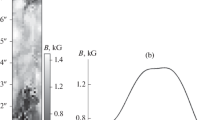Abstract
A simple model of a slowly rotating stellar or planetary atmospheric convection zone is considered supposing that only growing convective perturbations contribute to the value of nonlinear azimuthal force maintaining the differential rotation of the zone. Besides, the angular velocity of rotation is assumed to be dependent only on the distance to the center. It turns out that in this model some resonance phenomenon is possible, due to which a structure can be formed with a large rotation velocity gradient. This is caused by the interaction of two different azimuthal forces, one being proportional to either the angular velocity or its derivatives, while the other being determined by some mean value of the same velocity. The latter force appears in consequence of different time-dependence of the perturbations in rotating versus nonrotating convective zones.
A hypothesis is put forward that fast rotation of the upper atmosphere of Venus is due to such resonance interaction.
Similar content being viewed by others
References
Burangulov, N. I., Zilitinkevich, S. S., Kerzhanovich, V. V., Monin, A. S., Rozhdestvenski, M. K., Safrai, A. S., Turikov, V. G., and Chalikov, D. V.: 1974,Dinamika Atmosfery Venery (Dynamics of Venus Atmosphere), Nauka, Leningrad.
Durney, B. R.: 1981, in R. Dunn (ed.),Solar Instrumentation, Sacramento Peak Obs.
Glatzmaier, G. A. and Gilman, P. A.: 1981,Astrophys. J. Suppl. Ser. 45, No. 2.
Kuz'min, A. D. and Marov, M. Ya.: 1974,Fizika planeti Venera (Physics of Planet Venus), Nauka, Moscow.
Monin, A. S.: 1980,UFN (Progress in Phys. Sci., U.S.S.R.) 132, 123.
Rossow, W. B., Fels, S. B., and Stone, P. H.: 1980,J. Atmospheric Sci. 37, 250.
Rüdiger, G.: 1980,Geophys. Astrophys. Fluid Dynamics 16, 239.
Stone, P. H.: 1975,J. Atmospheric Sci. 32, 1005.
Traub, W. A. and Carleton, N. P.: 1979,Astrophys. J. 227, 329.
Vandakurov, Yu. V.: 1975a,Solar Phys. 40, 3.
Vandakurov, Yu. V.: 1975b,Solar Phys. 45, 501.
Vandakurov, Yu. V.: 1976,Konvektsiya na Solntse i 11-letni tsikl (Convection in the Sun and the 11-Year Circle), Nauka, Leningrad.
Vandakurov, Yu. V.: 1978, in A. B. Severny (ed.),The Problems of the Magnetic Fields in the Cosmos, Crimea.
Young, R. E. and Pollack, J. B.: 1977,J. Atmospheric Sci. 34, 1315.
Young, R. E. and Pollack, J. B.: 1980,J. Atmospheric Sci. 37, 253.
Author information
Authors and Affiliations
Rights and permissions
About this article
Cite this article
Vandakurov, Y.V. A model of the atmospheric convection zone with a large increase of rotation velocity between its bottom and top. Astrophys Space Sci 83, 105–116 (1982). https://doi.org/10.1007/BF00648543
Received:
Issue Date:
DOI: https://doi.org/10.1007/BF00648543



